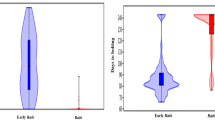Abstract
The oat crop has been neglected due to its use in limitation as a forage crop rather than a staple food in most of the countries throughout the world. Also it is more prone to foliar diseases, especially Helminthosporium leaf blight (HLB, syn Pyrenophora leaf spot) disease in the Punjab, especially Ludhiana region. It emerged as a new disease that can infect over 70% of the field resulting in up to forage yield losses of 50 per cent throughout. Hence, this study was conducted to evaluate the 167 germplasm lines for disease severity and its infection based on 1–9 scale through artificial inoculation of fungal spores. These lines were classified under four different clusters based upon infection with majority falling under cluster 2 and cluster 3 with infection of more than 50%. Lines ranged from being highly susceptible (more than 75% infection) to moderately resistant (22% infection). These contrasting lines were used in disease progression studies and also in hybridization programme to develop populations for future mapping studies. The contrasting lines were analysed for polymorphism using 220 SSR markers, of which 47 markers were polymorphic. Also the mapping for HLB resistance genes/QTLs is being carried out under the current ongoing research project, which will be the first research to map the resistance genes/QTLs in the oats throughout India and the world. Identified lines also can be used in future breeding programme to develop resistant cultivars.






Similar content being viewed by others
References
Boshoff WH, Visser B, Terefe T, Pretorius ZA (2019) Diversity in Puccinia graminis f. sp. avenae and its impact on oat cultivar response in South Africa. Eur J Plant Pathol 155:1165–1177
Braithwaite M, Alexander B, Adams RL (1998) Nationwide survey of pests and diseases of cereal and grass seed crops in New Zealand. In: Proceedings of the 51st New Zealand plant protection conference 51, 51–59
Carmona MA, Zweegman J, Reis EM (2003) Detection and transmission of Drechslera avenae from oat seed. Fitopatol Bras 29:319–321
Chełkowski J (1995) Helminthosporia: metabolites, biology, plant diseases: Bipolaris, Drechslera, Exserohilum. Inst Plant Genet 9:10–12
Dennis RW (1933) Studies in the morphology and biology of Helminthosporium avenae. Trans Br Mycol Soc 18(3):223
FAOSTAT (2015) Food and Agricultural Organization of United Nations Database. http://www.fao.org
Ghany TM (2013) Fungal leaf spot of maize: pathogen isolation, identification and host biochemical characterization: Mycopath 10(2)
Gupta O, Rathi M, Mishra M (2012) Screening for resistance against Rhizoctonia Bataticola causing dry root-rot in Chickpea. J Food Legumes 25:139–141
Kapoor R, Choudhary (2017) Oats in broadening the genetic base of grain cereals. Springer 12:127–162
Kumari T, Jindal Y, Satpal (2019) Genetic diversity and variability analysis in oats (Avena sp) genotypes. Electron J Plant Breed 10:331–334
Lashram MA (2019) Some studies on leaf spot of oats and triticale. M.Sc Theses, South Dakota State University, USA
Murphy JP, Hoffman LA (1992) The origin, history and production of oat. Agron 134:14–19
Ragiba M, Prabhu KV, Singh RB (2004) Recessive genes controlling resistance to Helminthosporium leaf blight in synthetic hexaploid wheat. Plant Breeding 123(4):389–391
Sharma RC, Duveiller E, Gyawali S, Shreshta SM, Chaudhary NK, Bhatta MR (2004) Resistance to Helminthoporium lleaf blight and agronomic performance of spring wheat genotypes of diverse origins. Euphytica 139:33–34
Simko I, Piepho HP (2012) The area under the disease progress stairs: calculation, advantage, and application. Phytopathology 102(4):381–389
Turner DM, Millard WA (1931) Leaf‐spot of oats, Helminthosporium Avenae (Bri. And Cav.) Eid: Ann Appl Biol 18(4):535–558
Zhou X, Jellen EN, Murphy JP (1999) Progenitor Germplasm of domesticated oat. Euphytica 12:89–91
Author information
Authors and Affiliations
Corresponding author
Additional information
Communicated by P. S. Baenziger.
Rights and permissions
Springer Nature or its licensor holds exclusive rights to this article under a publishing agreement with the author(s) or other rightsholder(s); author self-archiving of the accepted manuscript version of this article is solely governed by the terms of such publishing agreement and applicable law.
About this article
Cite this article
Hilli, H.J., Kapoor, R., Singla, A. et al. Towards mapping of Helminthosporium leaf blight/Pyrenophora leaf spot resistance genes/QTLs in oats. CEREAL RESEARCH COMMUNICATIONS 51, 471–481 (2023). https://doi.org/10.1007/s42976-022-00306-w
Received:
Accepted:
Published:
Issue Date:
DOI: https://doi.org/10.1007/s42976-022-00306-w




